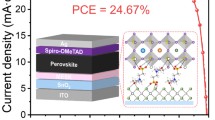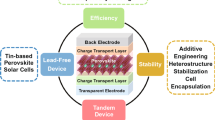Abstract
In this paper, three commonly used methods for boron-rich layer (BRL) (BRL: abbreviation of boron-rich layer, a layer constituted by compound of boron and silicon.) removal and their impacts on the surface passivation and the efficiency of the final interdigitated back contact solar cells are investigated. The method of in-situ oxidation can remove BRL completely, but will cause serious degradation of the bulk lifetime. The method of treatment in boil nitric acid cannot remove BRL completely resulting in a poor passivation quality of the substrate surface. The method of chemical etch treatment (CET) (CET: Abbreviation of chemical etch treatment.) can remove BRL completely and would not cause any degradation of the bulk lifetime. Finally, interdigitated back contact solar cells have been fabricated using the three methods mentioned above for BRL removal and the highest efficiency of 21.17% is achieved with the BRL removed by the method of CET.




Similar content being viewed by others
Notes
TNBA: Abbreviation of treat in boiling nitric acid.
References
D. Macdonald, L.J. Geerligs, Appl. Phys. Lett. 85, 4061 (2004)
J. Zhao, A. Wang, P.P. Altermatt, M.A. Green, J.P. Rakotoniaina, O. Breitenstein, Proc. 29th IEEE. PVSC. 5, 218 (2002)
J. Knobloch, A. Noel, E. Schaeffer, U. Schubert, F.J. Kamerewerd, S. Klussmann, W. Wettling, Proc. 23th IEEE. PVSC. 23, 271 (1993)
M. Taguchi, A. Yano, S. Tohoda, IEEE J. Photovolt 4, 96 (2014)
P. Procel, A. Ingenito, R.D. Rose, Prog. Photovolt. 25, 452 (2017)
M.A. Kessler, T. Ohrdes, B. Wolpensinger, N.P. Harder, Semicond. Sci. Technol. 25, 9 (2010)
A. Das, K. Ryu, A. Rohatgi, IEEE J. Photovolt. 1, 146 (2011)
N. Wehmeier, G. Schraps, H. Wagner, B. Lim, N.P. Harder, P.P. Altermatt, Proc. 28th EU. PVSEC. 28, 1980 (2011)
S.P. Phang, W. Liang, B. Wolpensinger, M.A. Kessler, D. Macdonald, IEEE J. Photovolt. 3, 261 (2013)
E. Arai, H. Nakamura, Y. Terunuma, J. Electrochem. Soc. 120, 980 (1973)
C. Kim, S. Park, Y.D. Kim, H. Park, S. Kim, H. Kim, H. Lee, D. Kim, Thin. Solid. Film. 564, 253 (2014)
B. Singha, C.S. Solanki, Mat. Sci. Semicon. Proc. 57, 83 (2017)
K. I.Kurachi, Yoshioka, Jpn. J. Appl. Phys. 53, 036501–036504 (2014)
B. Singha, C.S. Solanki, Semicond. Sci. Technol. 31, 0355001–0355009 (2016)
S.Z. Yang, J.L. Li, H.B. Yang, X.J. Li, C. Ye, X. Liu, Yuan, J. Mater. Sci-Mater. El. 29, 20081 (2018)
S. Meier, S. Lohmüller, S. Mack, A. Wolf, S. W. Glunz, AIP Conf. Proc. 1999, 070003 (2018)
C.J. J.Ryu, A. Choi, Y.W. Rohatgi, Ok, Curr. Appl. Phys. 16, 497 (2016)
K. Ryu, A. Upadhyaya, H.J. Song, C.J. Choi, A. Rohatgi, Y.W. Ok, Appl. Phys. Lett. 101, 073902 (2012)
C.J. L.Ryu, H. Choi, D. Park, A. Kim, Y.W. Rohatgi, Ok, Sol. Energ. Mat. Sol. C. 146, 58 (2016)
B. Singhaa, C.S. Solankib, Energy. Proc. 57, 117 (2014)
P. Negrini, A. Ravaglia, S. Solmi, J. Electrochem. Soc. 125, 609 (1978)
Z.Y. Yu, S. Jiang, X.W. Dai, K. Tao, C. Zhang, S.W. Duo, R. Jia, Adv. Eng. Res. 148, 357 (2017)
C.X. Hou, R. Jia, K. Tao, S. Jiang, P. fF., H.C. Zhang, S.J. Sun, M.Z. Liu, X.H. Peng, J. Semicond. 39, 122004–122011 (2018)
D.E. Kane, R.M. Swanson, Proc. 18th IEEE. PVSC. 18, 578 (1985)
Acknowledgements
This work was supported by the Project of Beijing Municipal Science and Technology Commission (Grant no. Z151100003515003) and National Natural Science Foundation of China (Grant no.110751402347).
Author information
Authors and Affiliations
Corresponding author
Additional information
Publisher’s Note
Springer Nature remains neutral with regard to jurisdictional claims in published maps and institutional affiliations.
Rights and permissions
About this article
Cite this article
Jiang, S., Jia, R., Tao, K. et al. Different methods for removing boron-rich layer and their impacts on the efficiency of interdigitated back contact solar cells. Appl. Phys. A 125, 264 (2019). https://doi.org/10.1007/s00339-019-2563-3
Received:
Accepted:
Published:
DOI: https://doi.org/10.1007/s00339-019-2563-3




